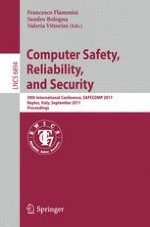2011 | Buch
Computer Safety, Reliability, and Security
30th International Conference,SAFECOMP 2011, Naples, Italy, September 19-22, 2011. Proceedings
herausgegeben von: Francesco Flammini, Sandro Bologna, Valeria Vittorini
Verlag: Springer Berlin Heidelberg
Buchreihe : Lecture Notes in Computer Science
